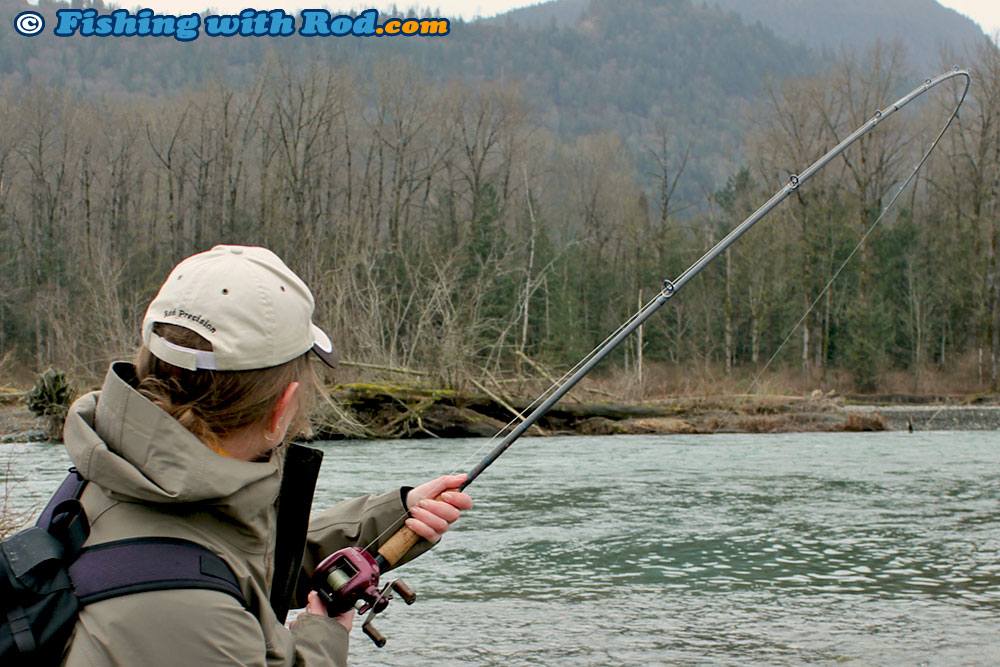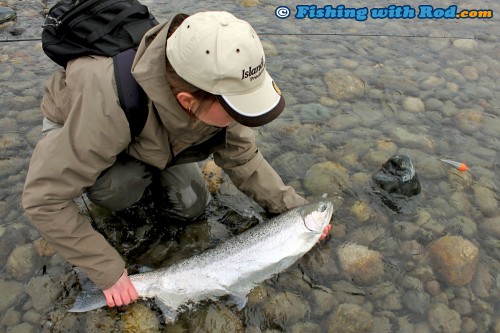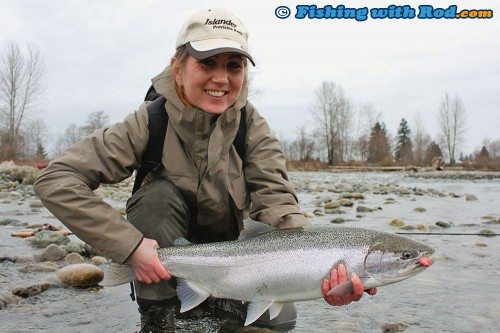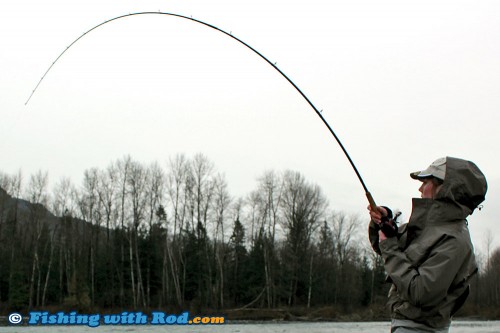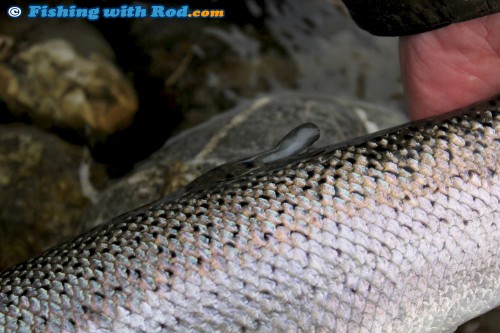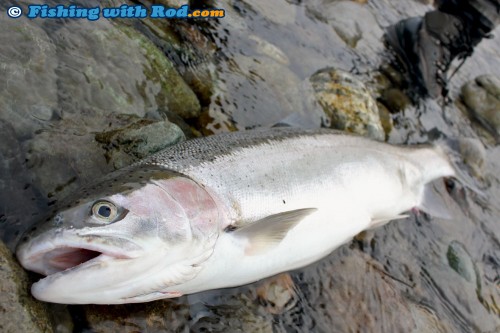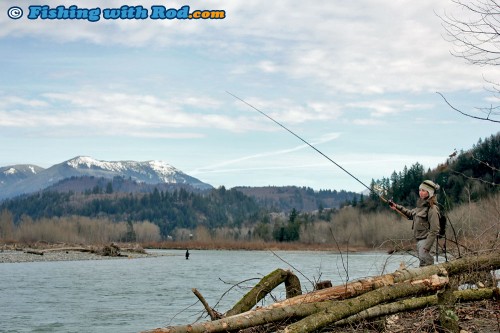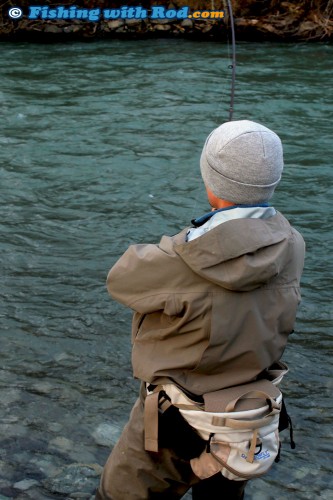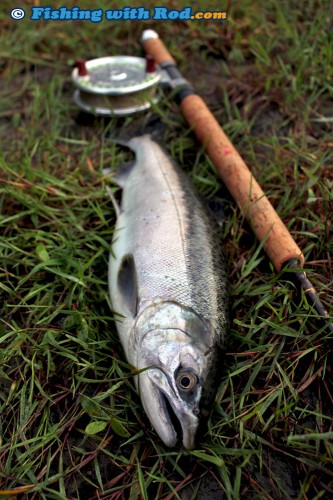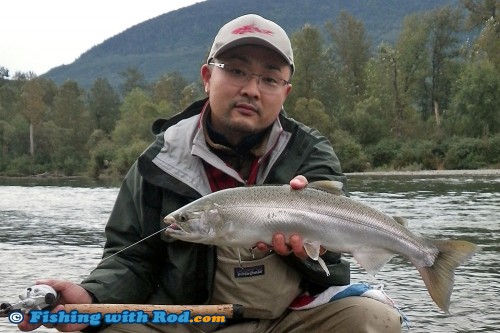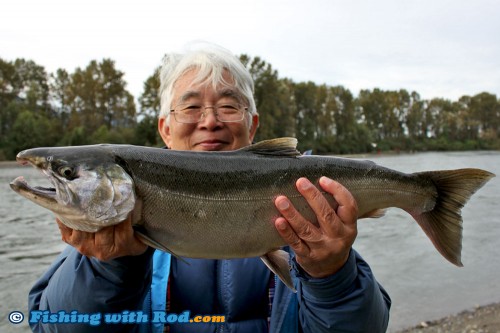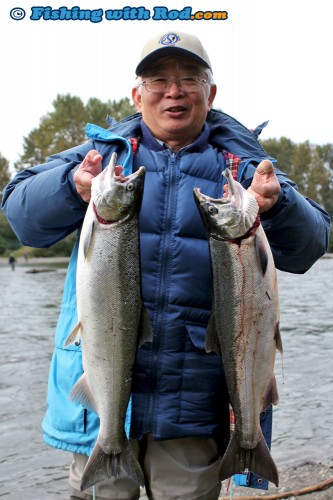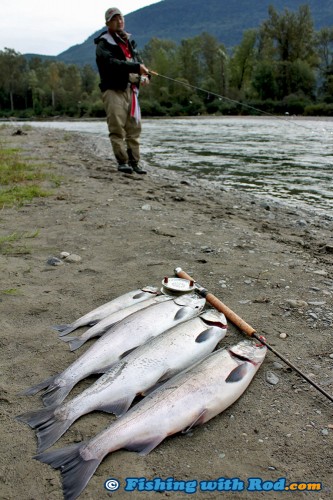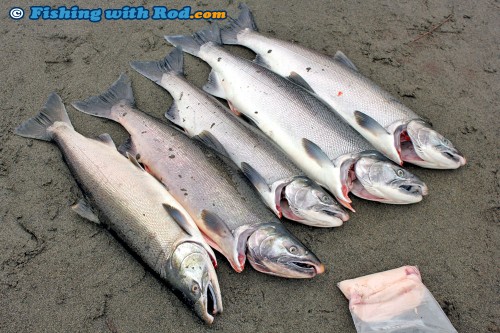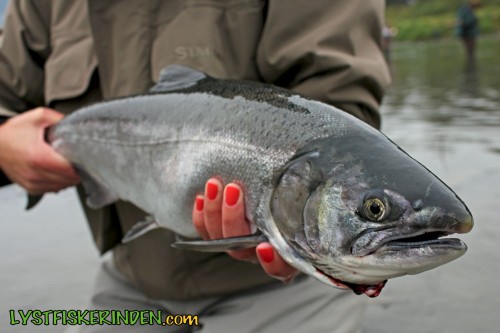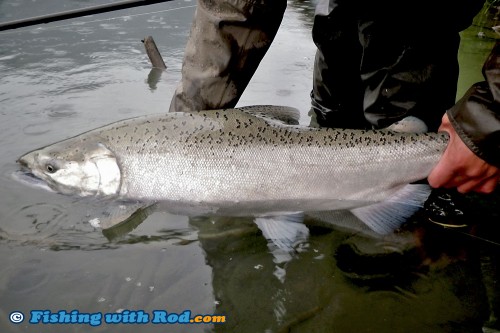A tug erases all doubts
Published on Saturday, February 11th, 2012
Despite of being disappointed after each trip to the Chilliwack River this winter, we are determined to bring a steelhead to the beach. After all, persistence is the name of this game. As my friend Chris always says, “You are one cast closer to the next fish.” so the only way to succeed is to invest lots of hours and don’t repeat past mistakes. Our trip usually starts with “today is the day!”, followed by “I can’t believe how unlucky we are” at the end of the trip. One has to wonder why anyone would put themselves through these psychological roller coasters for a tug on the line.
Earlier this week, we returned to the same spot where I lost two fish in a row during last week’s outing. We decided to give first light a go, but that simply did not work out. After hunting for these elusive bullets for a few hours, we were pretty tired and obviously came home empty handed. An early start is definitely not my cup of tea for steelhead fishing. Most of my successful outings have been in an afternoon start, when you can relax and scout out where the fish may possibly be. Sometimes late afternoon can be just as productive as early morning. The morning crowd usually disperses by Noon, leaving the river pretty vacant.
On Thursday, Nina and I decided to give it one more go after hearing success stories from our friends. We arrived at the river bank just past Noon. The weather could not have been better for steelhead fishing. It was cloudy and drizzling at times. Water was also not too clear. It silted up slightly as the day went by, providing some cover for unsuspecting fish.
We picked a different spot this time. After walking and fishing through the same runs for three weeks, the repeating scenery was getting rather stale. Instead, we were advised by Chris to try out a few spots where he has had some luck recently. When we arrived at the chosen spot, we were delighted to find only a couple of anglers fishing in the area.
The spot where we started was a potential holding hole for fish, but not so great for landing a fish. The fast water ran tightly along the bank, making it a steep drop-off directly in front of us. The tail end of the spot had another channel feeding into the main run, so there wasn’t any shallow spot where we could simply bring the fish in. But who cares? It’s kind of silly to worry about landing a fish when hooking them has already been a struggle.
I baited up newly tied roe bags on both of our hooks and started drifting through where we thought the fish might be. Within a few casts, my float quickly took a dive! Not only did it disappear, the fish also pulled the rod tip down, yet for some reason I was asleep at the wheel. I did not even lift my arm! The pathetic performance was obviously not rewarded. The brief tension instantly vanished before I even realized what had happened. I was both excited and frustrated, explaining to Nina what she just missed. She didn’t pay much attention, focusing on her float that was wandering pretty far downstream. She drifted it past a log jam a few times before it was finally her turn to battle with a steel.
When she started retrieving her roe bag at the end of one drift, a fish suddenly grabbed it. Totally surprised by the unexpected take, she held onto the rod while the fish bolted downstream with the strong current. Adrenaline was pumping high, we now had to quickly figure out how to bring this fish in. The only option I could see was to cross the feeding channel so we could follow the fish downstream. To do so, we had to walk upstream and away from the bank slightly, but the angle of the line would bring the fish toward the log jam. I guided Nina upstream. She slowly walked backward while attempting to keep the fish under control. I took the first step into the fast flowing channel and anchored myself so I could grab her as she followed. Both of us took several firm and slow steps across the channel.
Once we were on dry bank again, I told her to make her way downstream fast to avoid the log jam. It was too late, I could see the float caught up on a twig sticking out from the jam. I ran down to free it and expected to see a fishless hook dangling by the branch, but I was quite relieved to discover that the fish was still on. Once the line was freed, Nina could start gaining some control. We were not out of the woods yet, because the fish somehow brought her back to the same twig again! I freed the line for the second time and surprisingly the fish remained on the line. “Keep the rod high!”, I shouted. Eventually she was able to clear the entire log jam and brought the fish to a shallow opening.
By this point, Nina’s arms were ready to give up. Who knew steelheading can be quite a workout? She tucked the rod under her left arm and used her entire upper body to guide the fish in. It was a magnificent fish, roughly around 10lb. I could see the adipose fin, meaning it was a wild fish which needed to be released. She slowly brought it into the shallow, but it made a few more darts as soon as its belly felt the submerged gravel. Finally, after several minutes of uncertainty, I had a firm grip of its tail. Nina’s first steelhead of the season was landed!
We took a couple of photographs before removing the hook and releasing it. I opened its mouth slightly and the hook slipped out without any pressure being applied on it. The leader was frayed nicely from its teeth and the log jam. This fish would most likely not have been landed if it took a few more runs.
Both elated and exhausted by her catch, Nina took a break while I returned to where I thought the fish might be. It actually did not take long before my float was swiftly pulled down. For some reason, I once again did not react! There was no doubt it was a bite. The depth of the water was a lot deeper than my float depth. I turned around, waved and explained frantically to Nina what just happened as if I had witnessed a car accident. Usually when a miss occurred, the fish will come back so I drifted through the same spot many more times. During one of these drifts, a fish suddenly surfaced and rolled at the exact same spot where the float went down! This confirmed that it was indeed a fish earlier.
We worked through the run for another half hour without any success. It was time to move. Even though we knew the fish were there, sometimes it is best to keep going and find fish that are more willing to bite. We took a walk downstream, found a few more runs where the fish may hide and did some casts. After two more hours of scouting around, we returned to our original spot with one hour of daylight left, hoping for an evening bite.
I, of course, started out at where I saw a fish rolling earlier. A dozen drifts went by and it didn’t seem to like my roe bag. Seeing my lack of success, Nina decided to try the same spot while I moved a bit further upstream. Perhaps it was the roe bag, the drift, luck, or dare I say it, the angler’s skill, Nina soon connected with her second fish of the day! It happened so fast. I was actually taking a break from the rod and hoping to capture some photographs of her fishing. While adjusting the settings on the camera, I looked up for a moment and saw her rod kicking furiously. She turned around and looked at me in disbelief. I did not need to tell her what to do, since she already brought one in at the same spot!
Perhaps it did not have the strong current or the log jam as its advantage, this fish was more manageable. Nina was able to bring it in without much struggle. I tailed the fish in the shallow, checked for an adipose fin and saw a healed scar but a tiny remnant of the adipose could still be seen.
It was clearly a hatchery-marked fish, but a mis-clipped, meaning the fish’s adipose fin was not completely snipped off during its juvenile stage at the hatchery. Pretty confident that it was not a wild fish, I asked Nina if she would like to keep it. “Sure!”, she said of course, since we did not have much daylight left for fishing anyway. It was the perfect end to a day of steelhead fishing on the Chilliwack River.
I concentrated my effort on fishing through the same spots with the little amount of time left, while Nina patiently waited with a large grin on her face. The river was not about to reward my mistakes on this day. After all, I also had two opportunities to dance with a chromer but failed to grab them. I was both excited for Nina’s catches and also the possibilities in our future trips. When you go on without a single bite for so long, you often start doubting your bait, your spot and yourself. Those doubts are instantly erased when you’re greeted by a tug, then the whole process repeats itself. For newbies, this is an ongoing love and hate relationship with this ridiculous activity that we call steelheading.

